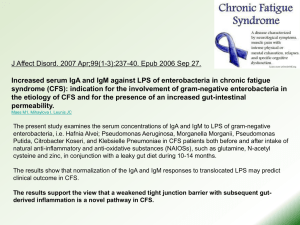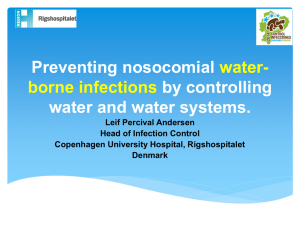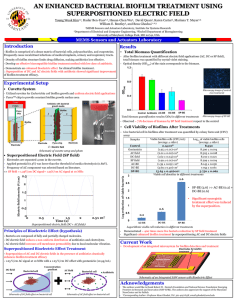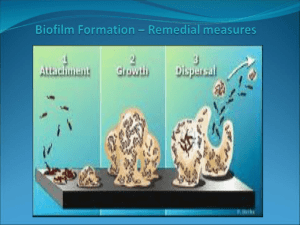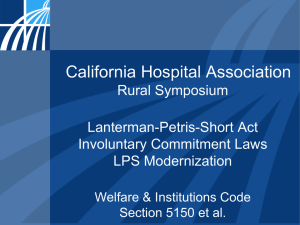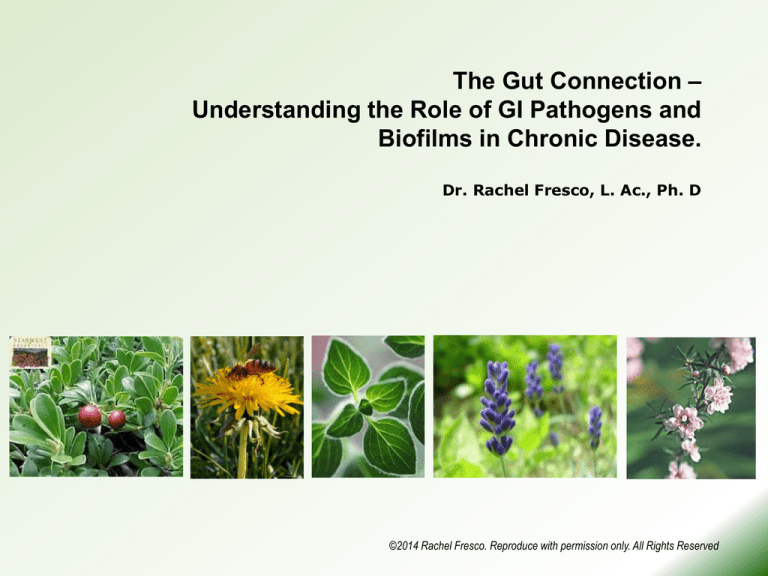
The Gut Connection –
Understanding the Role of GI Pathogens and
Biofilms in Chronic Disease.
Dr. Rachel Fresco, L. Ac., Ph. D
©2014 Rachel Fresco. Reproduce with permission only. All Rights Reserved
Anatomy of a Biofilm
• Communities of microbial cells surrounded by a secreted
polymer, called the extracellular polymeric substance or EPS
which is an endotoxin.
• Discovered by Anton Von Leeuwenhook the “father of
microbiology” when he inspected dental plaque
• Composed of multiple organisms, including both aerobic and
anaerobic bacteria and/or fungal species
• More than 80% of all microbial infections have developed
biofilms beginning in as little as two weeks from the onset of
infection
• Cause 2 million HAI infections and 100,000 deaths annually
• Biofilm bacteria can resist up to 5000 times the antibiotic
concentration that would normally be needed to resolve
infections.
What is LPS – Component of Biofilms?
Structure of Lipopolysacchride (LPS) Endotoxin
Biofilm Associated Infections
Chronic Sinusitis
Biofilms of both yeast and/or bacteria
are found in 80% of patients
undergoing sinus surgery.
Pulmonary Infections
Bacterial and fungal biofilms can cause
chronic infection such as pneumonia,
cystic fibrosis, and tuberculosis.
Staph aureus biofilm
on a catheter
Kidney Stones
Stones consist of a complex composed
of bacterial biofilm, and mineralized
stone material.
Heart Disease
Inflammation of the smooth membranes
which line the inside of the heart is
caused by a complex biofilm composed
of both bacterial LPS and host
components. Biofilms have been found
on stents and other cardiac prosthetics.
Pseudomonas A. biofilm
inside the alveoli in the
lung
MRSA
Biofilm Associated Infections
Inner Ear Infections
The majority of ear infections, (OM) are caused by
biofilm bacteria and or fungal infection. OM is the
most common illness for which children visit a
physician, receive antibiotics, or undergo surgery
in the United States. Two thirds of post operative
tissue cultures have biofilms.
Otitis Media Biofilm
Periodontal Disease
Over 500+ microbial biofilm species colonize the
human mouth, causing tooth decay and chronic
gum disease, and these bacteria can migrate
throughout the body causing a variety of
infections.
In many cases of periodontal infection C. albicans
and S. aureus co-colonization makes it difficult to
treat.
Dental Biofilm
Chronic Wounds
Biofilms have been implicated in chronic wounds,
including antibiotic resistant Staph such as MRSA.
MRSA
Autism, MS, Lyme
Chronic Neuro-Excitotoxicity
Brain and nerve cell loss, as seen in
Autism, MS, and Parkinson’s
Resting Microglia
50-70% of MS patients test positive
for infection. 80-100% of autistic
children have abnormal yeast and
bacterial loads.
Biofilm Infections Found Include:
Yeast
Bacteria
Viruses
Parasites
Lyme Disease and co-infections
Mycoplasma
Chronic infections need to be
treated to stop persistent activation
of microglia and nervous system
damage.
Activated Microglia
Neuro-inflammation plays a
prominent role in the progression of
Alzheimer's disease
Chronic brain inflammation leads
to a decline in hippocampal
NMDA-R1 receptors
LPS causes activated Microglia
Figure 1: Confocal microscope images of activated microglial cells MHC II (green OX-6 positive) in the
Dentate Gyrus. Rats infused with aCSF (A) had only a few activated microglia scattered throughout the
brain. Chronic infusion of LPS into the 4th ventricle produced high activated microglia distributed throughout
the hippocampus (B). Higher magnifications of an activated microglia (C, D
Rosi S, Ramirez-Amaya V, Hauss-Wegrzyniak B, Wenk GL - J Neuroinflammation (2004)
In summary, the systemic injection of LPS resulted in
the reactivation of Collagen-induced arthritis in mice
that was associated with the increased production of
anti-CII IgG and IgG2a antibodies as well as the
enhanced secretion of cytokines including IL-12, IFNγ, IL-1β, and TNF-α. Thus, LPS may play a role
in the exacerbation of autoimmune diseases.
These results suggest that molecular associations
between LPS/TLR4/collagen type II in chondrocytes
up-regulate the NF-kappaB and PI-3K signalling
pathways and activate pro-inflammatory activity.
Thus, LTA shares with LPS endotoxin many of its pathogenic
properties. In animal studies, LTA has induced arthritis, nephritis,
uveitis, encephalomyelitis, meningeal inflammation, and
periodontal lesions, and also triggered cascades resulting in septic
shock and multi-organ failure.
Biofilms, LPS, LTA in G.I. Disease
Intestinal Dysbiosis and Leaky Gut Syndrome
Perforation of the GI lining by pathogenic
bacteria, yeast or parasites, resulting in LPS
and LTA endotoxin translocation.
Chronic GI Dysbiosis:
Linked to arthritis, cardiac disease, fibromyalgia,
auto-immune disorders,
nerve and brain cell inflammation.
Candida
Hyphal forms invade epithelial cells and cause
tissue damage. Toxic by-products of yeast such as
acetaldehyde are carried to distant parts of the
body including the brain. AH damage to red blood
cells impairs oxygen transport.
(20% of oxygen intake is used by the brain).
C. Difficile Infection
3 million cases in hospitals in the US, one study
found 20% of nurses uniforms contaminated by the
end of a workday. Not killed by alcohol, soap and
water or bleach is needed.
Chronic Inflammation
Seen in acid reflux, GERD, colitis,
Crohn’s disease.
Neurotransmitter Disregulation
Sleep and mood disturbances.
C. Difficile Biofilm
Bacterial lipopolysaccharides (LPS) variably
modulate in vitro biofilm formation of
Candida species.
13
Zonulin and Systemic Inflammation:
Celiac / Gluten Intolerence and Leaky Gut Syndrome
When the finely-tuned Zonulin pathway is deregulated in genetically susceptible
individuals, both intestinal and extra-intestinal autoimmune, inflammatory, and
neoplastic disorders can occur.
Dr. Alessio Fasano
Director
Center for Celiac Research
Mass General Hospital
for Children
www.celiaccenter.org
Mechanisms of gliadin-induced zonulin release, increased intestinal permeability, and onset of autoimmunity.
From Zonulin and Its Regulation of Intestinal Barrier Function: The Biological Door to Inflammation, Autoimmunity, and Cancer
LPS, Zonulin and Systemic Inflammation:
Intestinal Dysbiosis and Leaky Gut Syndrome
Lipopolysaccharides (LPS) are endotoxins comprised of
structural components of Gram-negative bacteria that
may be discovered in plasma through an Intestinal
Antigenic Permeability Screen. The presence of LPS in
the blood is a ”smoking gun” for intestinal permeability
caused by intestinal dysbiosis, and may indicate a
chronic biofilm encapsulated infection
Intestinal Antigenic Permeability
Screen
Actomyosin IgA
Occludin/Zonulin IgG
Occludin/Zonulin IgA
Occludin/Zonulin IgM
Lipopolysaccharides (LPS) IgG
Lipopolysaccharides (LPS) IgA
Lipopolysaccharides (LPS) IgM
www.cyrexlabs.com
Ann. N.Y. Acad. Sci. 1165: 195–205 (2009)
Elevated serum zonulin was
detected in 70% of autoimmune
subjects
16
Physiol Rev 91: 151–175, 2011
Among the several potential intestinal luminal
stimuli that can trigger zonulin release, we identified
small intestinal exposure to bacteria and gluten as
the two more powerful triggers.
17
Autoimmune Disease
“Emerging evidence has suggested the involvement of
environmental factors such as infections and
xenobiotics, and some dietary proteins and their
antibodies in the pathogenesis of many autoimmune
diseases.
These antibodies appear in the blood years before
presentation of symptoms in various disorders. Therefore,
these antibodies may be used as biomarkers for early
detection of various diseases.”
ALTERNATIVE THERAPIES, jan/feb 2013, VOL. 19, NO.1
Dr. Aristo Voljdani, Ph. D.
Mucosal Immunol. 2010 July ; 3(4): 387–
398.
Translocation of microbial products and the resulting
immune activation have not only local consequences
within the GI tract, but are also associated with systemic
dissemination of LPS and systemic immune activation
19
SIBO -Small Intestine Bacterial Overgrowth
Of the 42 fibromyalgia patients, 100% were positive for SIBO. overgrowth
LPS From Viral Infected E. Coli
Theophil Hey, MD and colleagues found that 80% or more of those with fibromyalgia are harboring a
virus. It isn’t a human virus, but it is a virus that infects the E coli bacteria that is living in their
intestines. His testing showed that only 12% of the people without fibromyalgia had this infection.
When a group of fibromyalgia patients were tested during a flair of symptoms, 62 out of 63, or 98%
tested positive for this problem.
When the infected E coli die, they burst and produce fragments of the E coli shell. Gram-negative
bacteria, like E. coli, have a layer in their shell of a fatty substance called lipopolysaccharide (LPS).
LPS is highly toxic to humans.
J Affect Disord. 2007 Apr;99(1-3):237-40. Epub 2006 Sep 27.
Increased serum IgA and IgM against LPS of enterobacteria in chronic fatigue
syndrome (CFS): indication for the involvement of gram-negative enterobacteria in
the etiology of CFS and for the presence of an increased gut-intestinal
permeability.
Maes M1, Mihaylova I, Leunis JC
The present study examines the serum concentrations of IgA and IgM to LPS of gram-negative
enterobacteria, i.e. Hafnia Alvei; Pseudomonas Aeruginosa, Morganella Morganii, Pseudomonas
Putida, Citrobacter Koseri, and Klebsielle Pneumoniae in CFS patients both before and after intake of
natural anti-inflammatory and anti-oxidative substances (NAIOSs), such as glutamine, N-acetyl
cysteine and zinc, in conjunction with a leaky gut diet during 10-14 months.
The results show that normalization of the IgA and IgM responses to translocated LPS may predict
clinical outcome in CFS.
The results support the view that a weakened tight junction barrier with subsequent gutderived inflammation is a novel pathway in CFS.
LPS, Zonulin and Systemic
Inflammation:
Intestinal Dysbiosis and Leaky Gut Syndrome
Clinical Goals:
① Eliminate GI Dysbiosis due to pathogenic bacteria, yeast, fungus and parasites.
② Address biofilms and systemic infections, reduce LPS, LTA translocation
③ Eliminate allergens from the diet.
④ Support detoxification: liver and toxic metals, LPS burden
⑤ Raise antioxidants such as glutathione.
⑥ Support beneficial organisms with pre and probiotics.
⑦ Heal gut lining with Vit D-3, glutamine, other support supplements
These are really fundamental protocols in any patient with chronic inflammation or any
long term illness.
Antibiotic Therapy
Can be life-saving,
however…
Overuse has lead to resistant
strains and pollution of the
environment.
Are often ineffective in Biofilm and
“superbug”related infections
May disturb normal GI flora,
causing overgrowth of yeast or
bacteria, as seen in C. Difficile
infection
Research suggests botanicals may
assist antibiotic effectiveness
Antibiotics known to cause
C. Difficile:
Clindamycin
Ampicillin
Amoxicillin
Cephalosporins
Occasionally cause C. Difficile:
Penicillin
Erythromycin
Ciprofloxacin
Biofilm Control:
Utilizing Plant Based Medicines
•
Inhibition of Quorum Sensing
•
Inhibition of Initial Attachment Phase of
Biofilm Colonies
•
Inhibition of Swarming Motility
•
Multi-Drug Resistance Pump Inhibitors
•
Bacteriostatics / Bactericidals
24 hour Exposure to Botanical Combination
Inhibition of Quorum Sensing
Cell signaling by organisms using auto inducers called
Quorum Sensing determines gene expression,
virulence, resistance, and the development of biofilms.
Botanicals which
are known to inhibit
Quorum Sensing:
-
Garlic
Oregano
Bilberry
Bladderwrack
Essential Oils:
Prevention Adhesion and Disrupting or
Destroying Biofilm Components
Phenolics such as Thymol interact with surface proteins of bacteria, leading to an
alteration of the cell surface and interrupt the initial attachment phase of biofilm
formation.
Essential Oils may prove to be most useful in treating multi drug resistant gram
negative bacteria such as Pseudomonas, Escherichia and Acinetobacter.
Condensed Tannins:
Powerful OPC’s Control Biofilm Development by
Inhibition of Swarming Motility of Pathogenic
Organisms
Grape Seed and Bilberry contain condensed
tannins that prevent adherence of biofilms,
and may inhibit swarming motility of
bacteria.
OPC’s are also potentiators for Vit C,
providing numerous benefits in cellular
health and anti-aging medicine.
Representative images of P. aeruginosa swarming
motility under control conditions (A) and in the
presence of Cranberry (B) and Pomeranate (C) (both
100 μ/ml).
Efflux Pump Inhibitors:
Inhibition of Multi Drug Resistance Pumps
Tannins, berberine, and certain phenolics have
useful effects as efflux pump inhibitors.
Research indicates that these botanicals can
potentiate conventional antibiotics and increase
their effectiveness against a variety of both
gram positive and gram negative organisms.
Goldenseal, Black Walnut, White Willow,
Raspberry Leaf Bladderwrack, Uva Ursi, and
Garlic are a few botanicals that have been
studied as Efflux Pump Inhibitors.
Formulation Rationale for
Botanical Combinations:
•
Only medical grade botanicals
contain enough of the active
ingredients to be clinically
effective.
•
Like a symphony, individual
components must be in
harmony.
•
The goal in formulation is
achieved when a maximum
result is produced without
stressing the body or causing
unwanted side effects.
Combination Botanical
Formulas
•
Broad Spectrum of activity against gram positive and gram
negative bacteria, yeast, fungus, parasites and viruses.
•
Inhibition of biofilms through more than one mechanism of
action.
•
Acts both systemically and in the digestive system, and may be
used in acute or chronic infection.
•
Contains immune system modulators to up-regulate the body’s
own defenses.
•
Supports clearance of toxins through activation of drainage
pathways of the liver and kidneys.
•
Reduces inflammation and promotes healing of tissues to reverse
damage due to leaky gut.
•
A synergistic blend to produce desired results without side
effects or stress on organ systems.
Botanical Combination Formulas Address:
Dysbiosis and Leaky Gut
Candida
Lyme and co-infections
Skin infections
Viral
conditions
Upper respiratory infection
Dental/Gum infection
Urinary tract infection
Prostate inflammation
Auto-immune disease
Elderly or at risk individuals
During heavy metal chelation
Adjunct to cancer treatments
Any acute or chronic infection
USP Effectiveness
Testing of Botanical
Combination
Demonstrates inhibitory activity of
against both gram positive and
gram negative bacteria, yeast and
fungus.
Bilberry extract, Grape Seed extract,
Milk Thistle, Echinacea, Goldenseal,
Shiitake, White Willow, Garlic, Black
Walnut (hull and leaf), Raspberry,
Fumitory, Gentian, Noni, Tea Tree oil,
Galbanum oil, Lavender oil, Oregano oil
Text
Text
Bacteriostatic and Bactericidal
Botanicals
Bacterostatics: Prevent Replication of
Bacteria.
Berberine containing plants such as Goldenseal and
Gentian have demonstrated powerful bacteriostatic
action.
One study showed the effectiveness of berberine
against Staph. epidermidis, one of the most
common causes of skin infections. Sub-minimal
inhibitory concentrations block the formation of S.
epidermidis biofilm.
Bactericidals: Terminate Bacteria
Olive Leaf , Goldenseal, Bilberry, Grape Seed,
Shiitake, Noni, Black Walnut, Garlic, Gentian and
Fumitory are potent bactericides. Oregano, Tea
Tree , Lavender and Galbanum oils are essential
oils with excellent antimicrobial activity.
Combining Antimicrobial
Ingredients Provides Maximum
Effectiveness
•
•
•
Goldenseal
Contains Berberine with broad antimicrobial activity. Berberine
has also been shown to kill a wide range of organisms, such
as those that cause candida (yeast) infections, viruses, and
various parasites such as tapeworms and Giardia. Berberine
may also activate white blood cells, making them more
effective at fighting infection and strengthening the immune
system, in addition to helping to remove biofilms.
Gentian
Used to purify the blood since discovered around 167 B.C.,
Gentian is a digestive bitter. It also increases the activity of the
liver and gall bladder to improve their function, and is used to
improve absorption of nutrients, especially iron. Like
Goldenseal it also contains Berberine with a broad spectrum
of activity.
Echinacea Angustifolia and Purpurea
Contains active substances that enhance the activity of the
immune system, relieve pain, reduce inflammation, and have
antiviral, and antioxidant effects.
Combining Antimicrobial Ingredients
Provides Maximum Effectiveness
•
•
•
Olive Leaf
In vitro studies have shown that Oleuropein can inhibit
the growth of viruses, bacteria, fungi and parasites via
complex and novel methods including the inhibition of
enzymes necessary for bacterial growth and weakening
the cell wall of pathogens.
Garlic
A potent antioxidant and antimicrobial, garlic has been
used as medicine for thousands of years. Recent
research points to it’s cardiovascular benefits, anticancer properties and immune enhancing properties,
including inhibition of MDR pumps and Quorum
Sensing.
Black Walnut
Containing valuable tannins Black Walnut is not only
anti-parasitic but also anti-fungal, anti-viral and
antimicrobial. Extract of black walnut is reported to treat
eczema, herpes, psoriasis, fungal infections, and both
skin and internal parasites.
Medical Grade Essential Oils
•
•
•
•
Oregano
Oil of Oregano contains two key compounds, carvacrol and thymol.
Studies have shown that both of these compounds have significant
effects on harmful microorganisms and biofilm infections. In addition,
thymol can reduce bacterial resistance to common drugs such as
penicillin. Thymol has been shown to be an effective fungicide,
particularly against fluconazol (Difucan)-resistant strains. This is
especially relevant given that opportunistic Candida can cause severe
systemic infections.
Tea Tree
The oil has beneficial medical properties including antiseptic, antifungal
and antibacterial, actions. Tea tree oil has been used topically against
Staph including MRSA.
Lavender
Essential oil of lavender has antiseptic and anti-inflammatory properties.
It was even used to disinfect hospitals during WWI. Lavender oil is
extensively used for various respiratory infections, and has a calming
effect on the nervous system.
Galbanum
Mentioned in the Old Testament, as well as by Hippocrates, Galbanum
has one of the oldest recorded histories of beneficial use. It is both
antimicrobial and anti-parasitic and is traditionally used for healing
wounds and in the treatment of infection both internally and externally.
Detoxification Pathway Support
Removes Toxins and Decreases
Herxheimer Reactions, Supports Removal
of Biofilms
•
•
•
Dandelion
Although maligned as a lowly weed, dandelion has
numerous cleansing properties. It supports the liver and
kidneys and is a diuretic, allowing toxins to be eliminated.
The fresh juice may be applied directly to wounds The
leaves are high in minerals and vitamins.
Uva Ursi
A useful diuretic and antimicrobial, Uva Ursi contains plant
tannins that assist in removal of biofilm related infections,
and is often used to treat UTI.
Bladderwrack
A seaweed know for supporting thyroid function,
Bladderwrack also contains Fucoidan, which may prevent
adhesion of bacteria and viruses, also helping prevent
biofilm colonies from developing.
Immune Modulators
Increase Overall Immune System Activity,
Rejuvenate and Invigorate the Action of
Immune Cells.
•
•
•
Shiitake
Shiitake has numerous health benefits. Lymphokines, such as
interferon and interleukin stimulate the defense system,
increasing the number of phagocytes including macrophages
and other immune fighters that attack cancer cells, bacteria,
and viruses. Shiitake also has potent antibiotic effects against
other organisms.
Noni
Noni juice is an ancient health beverage possessing immune
stimulating, anticancer, antibacterial, anti-fungal, and anti-aging
properties. Several phytochemicals have been isolated from
noni fruit indicating potential anti-inflammatory activity. Noni
contains various powerful antioxidants that prevent free radicals
from damaging cells.
Cordyceps
The Cordyceps mushroom has a long history as medicinal
fungi. The earliest clear record is a Tibetan medical text in the
15th Century outlining the tonic properties. Recent research
has verified its’ unique healing capacity.
Antioxidants Quench Free Radicals
Powerful Extracts Increase Cellular Integrity and
Prevent Oxidative Stress, Inflammation and Tissue
Destruction.
•
Bilberry
Bilberries contain one if the highest levels of OPC’s and help
formation of and strengthening of connective tissue and
capillaries, and are used for ocular health. The anti-inflammatory
properties have also been helpful GI Dysbiosis. Bilberries inhibit
or kill fungi, bacteria, and protozoans.
•
Grape Seed Extract
Grape Seed Extract is another natural bioflavonoid which helps
strengthen and protect cell membranes from oxidative damage.
Catechins help reduce allergic responses by inhibiting enzymes
involved in the formation of histamine.
•
Raspberry
The fruit is high in ellagic acid, a phenolic compound that may
help prevent cancer and helps to stop biofilm formation.
Raspberry leaves are known historically for the treatment of
diarrhea. In addition, raspberry leaves can be used to treat
wounds, ulcers, and dental infections.
Clinical Goals Review:
① Eliminate GI Dysbiosis due to pathogenic bacteria, yeast,
fungus and parasites.
② Address biofilms and systemic infections, reduce LPS, and
LTA translocation
③ Eliminate allergens from the diet.
④ Support detoxification: liver and toxic metals, LPS burden
⑤ Raise antioxidants such as glutathione.
⑥ Support beneficial organisms with pre and probiotics.
⑦ Heal gut lining with Vit D-3, glutamine, other support
supplements
These are the fundamental protocols in any patient with chronic
inflammation or any long term illness.
©2014 Rachel Fresco. Reproduce with permission only. All Rights Reserved

